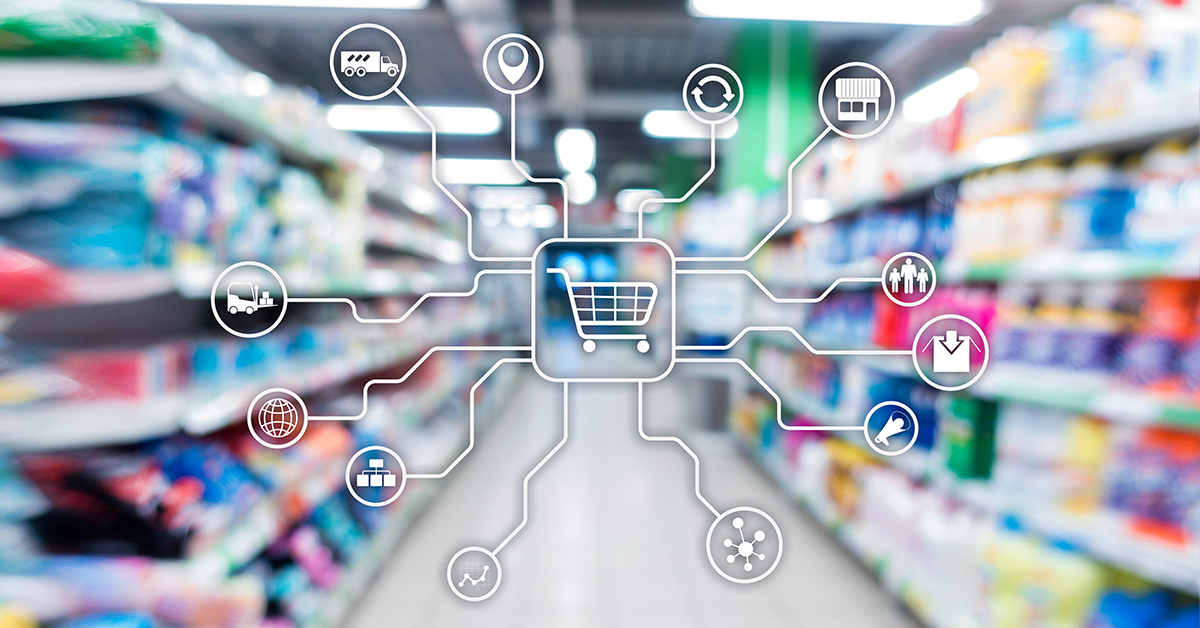What is Omnichannel Retail?
At its core, omnichannel retail focuses on enhancing customer experience by eliminating silos and ensuring a seamless transition between digital channels. By adopting a unified inventory management system, businesses can offer real-time visibility into product availability across online and offline stores, thereby maximizing sales opportunities and meeting customer demands efficiently.
Multichannel vs Omnichannel
One thing that is important to note is that simply operating on multiple channels is not enough to qualify as omnichannel retail. That is known as multi-channel retail.Multi-channel retail refers to the practice of having multiple sales channels, such as brick-and-mortar stores, online platforms, and mobile applications, operating independently of one another. Each channel functions as a separate entity with its own inventory, processes, and customer experiences. While multichannel experiences allow businesses to establish a presence across various touchpoints, it often leads to fragmented customer experiences. Customers may encounter inconsistencies in pricing, product availability, and overall brand experience when transitioning between channels.
Omnichannel retail, on the other hand, takes a more integrated and customer-centric approach. It focuses on providing a seamless and consistent shopping journey for customers across all channels. Rather than operating in silos, omnichannel retail strives to unify the customer experience, regardless of the channel they choose. This means that customers can start their shopping journey on one channel and seamlessly continue it on another without disruptions or inconsistencies. By integrating sales channels, inventory management, and data systems, businesses can offer real-time inventory visibility, personalized marketing initiatives, and a seamless brand experience.
The key distinction between omnichannel and multi-channel retail lies in the level of integration and consistency they provide. While multi-channel retail allows businesses to reach a wider audience, it often results in disjointed customer experiences. Omnichannel retail, on the other hand, offers a more holistic approach, enhancing customer satisfaction and fostering brand loyalty through a seamless and integrated shopping experience.
Omnichannel & The Modern Shopper
Access to technology and the evolution of online eCommerce has inherently changed the way people shop. In fact, customers have come to expect enhanced online shopping experiences that include features such as:
- Personalized shopping experiences
- Detailed product pages
- Inventory availability
- Multiple fulfillment options
And more. Ultimately, what customers are looking for above all else is convenience. Over 40% of consumers have switched brands, according to McKinsey. Although price is a main driver of switching, 72% of customers admit they are less loyal to a brand when it's hard to find what they want on a website. In other words, customers have come to expect a seamless experience across channels, making an omnichannel approach essential for staying competitive and meeting customer expectations.
The Top 6 Benefits of Omnichannel Retail
Omnichannel retail is vital to the retail customer experience for several reasons. It enhances customer satisfaction, boosts loyalty, provides real-time inventory information, meets customers where they are, and enables personalized experiences through data-driven insights. Retailers that embrace the power of omnichannel retailing position themselves to thrive in today's competitive landscape, delivering exceptional customer experiences and driving business growth.
Meets Shoppers Where They Are:
Probably the biggest benefit of omnichannel retail is being able to serve customers across multiple channels, meeting customers where they are, and capturing a larger slice of the market. In today's digital age, customers value convenience above all else, and this means showing up with products they want to see on their favorite platforms and channels. Whether customers prefer to shop online, visit physical stores, or engage through social media, retailers using omnichannel strategies can cater to their specific preferences. This flexibility allows retailers to capture a wider audience and tap into different customer segments. And by meeting shoppers where they are, retailers create convenience and seamless experiences, fostering stronger connections with their target audience.
Improves Sales & Revenue:
By seamlessly integrating multiple channels into a single ecosystem, retailers create a cohesive and consistent experience for customers. Whether browsing on a desktop, comparing prices on a mobile device, or visiting a brick-and-mortar store, customers can continue their journey without any disruptions. This is especially important as 53% of customers will abandon their cart completely if they cannot find even a single item they're looking for. And according to research from McKinsey, not only do omnichannel customers shop 1.7 times more, they also spend more. Smoother online shopping experiences lead to enhanced convenience and satisfaction, keeping customers engaged and brand loyal.
Increases Product Discovery:
With multiple channels at their disposal, customers have more opportunities than ever to explore and discover new products. By connecting these channels and seamlessly transferring customer data from one platform to the next, omnichannel retail experiences assist in creating personalized product discovery experiences. Whether it's enhancing filters and navigation, personalized product recommendations, or search results optimized for revenue, product discovery platforms that support omnichannel retail facilitate a richer and more diverse product discovery journey. Customers can easily find and explore products that align with their interests and preferences, uncovering hidden gems and expanding their choices.This leads to not only a more enjoyable online shopping experience but also opportunities for upselling and cross-selling, driving additional sales and revenue for the business.
Boosts Customer Loyalty:
One of the significant benefits of omnichannel retail is its ability to boost customer loyalty. By leveraging data and insights gathered across multiple channels, retailers can deliver personalized marketing messages and offers to their customers. This level of personalization makes customers feel valued and understood, increasing their likelihood of making repeat purchases and remaining loyal to the brand. And since returning customers spend 67% more than first-time buyers, this has significant implications for your bottom line and long-term revenue.
Decreases Customer Frustration:
Modern customers have come to expect to be able to see inventory status when they shop online. Options like curbside pick up and BOPIS (Buy Online, Pick Up In Store) are on the rise, being used by over one third of American shoppers, according to McKinsey. With a true omnichannel experience, customers can check the availability of items online and in-store, before they purchase, avoiding customer disappointment and missed sales opportunities.
Personalizes The Customer Experience:
By gathering data from multiple channels and utilizing advanced analytics, retailers can gain valuable insights into customer preferences, behaviors, and purchase history. This data-driven approach enables retailers to create tailored experiences and deliver targeted marketing campaigns. Customers receive customized recommendations and offers that align with their interests and needs, enhancing their overall experience and increasing the likelihood of conversion. And retailers who leverage next-generation search technology can display personalized search results that take into account a customer's preferences, like brands, styles, and colors. In this way, retailers can move beyond generic messaging and irrelevant promotions, ensuring that each interaction with the customer feels personalized and meaningful.
Current and Ongoing Challenges with Omnichannel Retail
Meeting and exceeding customer expectations is an ongoing challenge in the realm of omnichannel retail. Customers expect a consistent and personalized experience across all channels, along with convenience and flexibility in their interactions. However, despite these benefits, many retailers still struggle to deliver on omnichannel experiences today.
The connected, seamless digital shopping experiences that customers have come to expect are not simple to create, as they span multiple channels and touchpoints across the customer journey. Here are some of the biggest challenges retailers face today that are holding them back from delivering on true omnichannel shopping experiences.
Managing Multiple Platforms:
One of the significant challenges in omnichannel retail is managing multiple platforms. With customers accessing products and services through various channels such as websites, mobile apps, social media, and physical stores, it becomes crucial to provide a consistent and seamless experience across all touchpoints. This is particularly exacerbated by the second biggest challenge…
Connecting Online and Offline Data:
Connecting data from all platforms and sources, including online and offline data, is a major challenge for retailers. Customers often engage with a brand through different channels, making it essential to integrate and analyze their data holistically. However, different platforms offer different data points in different formats, making the integration difficult for retailers. Brands looking to excel in omnichannel commerce need to unify their data so it can be used further down the pipeline.
Technology Infrastructure:
Implementing and maintaining a robust technology infrastructure (especially across multiple touchpoints, and even more so when they present their data in different formats) is a vital challenge for successful omnichannel retail. Businesses need scalable IT systems that can handle the complexities of omnichannel operations, including data management, order fulfillment, and customer support. Integration with third-party systems and leveraging modern technologies must allow for streamlined operations, improved efficiency, and access to additional functionalities. To address these infrastructure challenges, many retailers are adopting a composable commerce approach to their omnichannel operations, selecting best-in-class modular components to keep their operations up to date.
Inventory Management & Supply Chain Coordination:
Efficient inventory management and supply chain coordination are essential elements of a seamless omnichannel retail experience. Today's customer expects to be able to see if products are in stock, and which stores have them. Real-time inventory tracking enables accurate stock availability information for customers, reducing the risk of stockouts, overselling and search abandonment.
Top 5 Ways to Measure and Optimize Omnichannel Retail
Of course, no retailer who's taken the time to invest in omnichannel retail would do so without measuring the results. In the ever-evolving eCommerce landscape, understanding the effectiveness of your strategies and maximizing your return on investment (ROI) is paramount. Here are the top 3 metrics to measure omnichannel ROI and performance.
- Conversion Rate:Omnichannel retailers have higher conversion rates than those who do not offer omnichannel, and implementing omnichannel initiatives can drive conversion rates higher.
- Customer Satisfaction:Measuring customer satisfaction through surveys, feedback, and reviews allows you to gauge how well your customers perceive the omnichannel experience.
- Customer Lifetime Value (CLV):CLV gives you visibility into long-term customer profitability, and in some cases customer loyalty. Measuring changes in customer loyalty or in CLV is a fantastic way to understand the holistic impact of your omnichannel strategy.
While other metrics can also deliver insight into omnichannel success, these are our favorites as they deliver valuable insights into your omnichannel retail performance and can help you optimize your business strategies. However, understanding your ROI and business performance is a continuous process that requires adaptability and a data-driven mindset. And measuring omnichannel effectiveness can be exacerbated by some of the technological challenges outlined above, making it even more important to have a solid technological underpinning for your omnichannel strategy.
Omnichannel In The Future: Emerging Technologies And Trends To Leverage For Future Growth
Omnichannel retail itself has evolved a lot since its introduction into the market years ago. The technology needed to execute on the vision of connected, consistent customer shopping experiences has advanced, and continues to develop, making way for new trends and technologies. Here are the top 3 emerging technologies and trends retailers will want to harness to continue delivering connected, seamless customer experiences in the future.
1. AI & ML: Unlocking Personalization and Insights
Imagine a shopping experience tailored specifically to your preferences, where every interaction feels like it was designed just for you. Where the first results in your search page or that show up on social commerce channels are perfectly aligned to your taste, even featuring your favorite brands, styles and colors. Or where the suggested products in a recommendations carousel perfectly compliment your purchase.
With the power of Artificial Intelligence (AI) and Machine Learning (ML), this vision is becoming a reality. Advanced algorithms and predictive analytics enable retailers to delve deep into customer data, uncovering valuable insights into their behavior and preferences.
By harnessing AI and ML technologies (especially those technologies that are optimized for retail and are focused on search and product discovery) retailers can provide personalized experiences that resonate with customers on a profound level. From personalized product recommendations to search results optimized for revenue, AI and ML empower businesses to connect with customers in a more meaningful way. This personalization not only enhances customer satisfaction but also drives increased sales and customer loyalty.
AI and ML can also greatly reduce manual interventions such as search tuning for eCommerce search and can nearly eliminate some administrative tasks. This frees up merchandising teams to focus on higher value business initiatives, monetization campaigns, and more strategic projects that only humans can handle.
2. AR & VR: Immersive Shopping Experiences
Augmented Reality (AR) and Virtual Reality (VR) technologies are revolutionizing the way customers interact with products and brands. With AR, customers can try on virtual products, visualize how furniture would look in their homes, or experiment with different makeup looks, all from the comfort of their devices.
VR takes this immersion to the next level, allowing customers to explore virtual shopping environments and engage with products in a lifelike manner. Virtual store tours enable customers to browse through the aisles, examine products up close, and make informed purchase decisions. These immersive experiences bridge the gap between online and offline shopping, providing a unique and captivating journey for customers.
By incorporating AR and VR into their omnichannel strategies, retailers can create engaging and memorable experiences that differentiate their brand. The ability to try products virtually and visualize them in real-life settings enhances customer confidence and reduces the likelihood of returns. And there's little reason to worry about customer resistance. More customers say they are likely to use AR/VR to assess products than they are to use a self-checkout!
3. Unified Commerce: Seamlessly Connected Experiences
Both omnichannel retail and unified commerce aim to create a customer-centric business model and provide an unparalleled experience. However, where omnichannel retail focuses on delivering a seamless customer journey across multiple channels and retaining customer information, unified commerce takes it further by integrating all business functions, channels, and data onto a single platform.
Unified Commerce ensures that customers have a consistent experience across all touchpoints, thanks to the concept of a single customer view. By consolidating customer data from various channels and creating a “single source of truth”, retailers gain a holistic understanding of their customers' preferences, purchase history, and interactions. This unified data allows for personalized recommendations, targeted marketing campaigns, and tailored promotions that resonate with individual customers.
In Summary
In today's highly competitive eCommerce landscape, omnichannel strategies are no longer a nice to have - they are a must have for retailers. By embracing the principles of omnichannel retail, brands can forge deeper connections with their customers, drive remarkable growth, and stay steps ahead of the competition.
As the future unfolds, the omnichannel experience will continue to evolve, driven by AI and ML, AR and VR, and the pursuit of Unified Commerce. Embracing these trends will empower retailers to deliver exceptional experiences, personalized engagements, and seamless interactions. Stay ahead of the curve and embrace the future of omnichannel retail to unlock new possibilities and drive success in the digital era.





